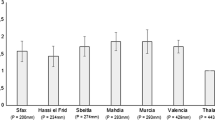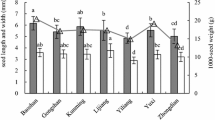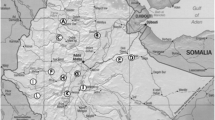Abstract
Seed and seedling traits govern plant fitness and persistence and are influenced by the interaction between the plant and its environment. Changing climatic and edaphic conditions will drastically affect early fitness-related traits and can alter the demography and species distribution range. It is widely documented that trait variation among populations may increase resilience of tree communities and reduce the risk of extinction under future climates. In the present study, variation in seed and seedling traits were documented from seven populations of Santalum album representing the natural distribution range of the species in the Indian subcontinent. Significant intra-specific variation was documented in seed and seedling traits, indicating high adaptive potential of the species. Further, the measured traits were correlated with climatic variables. No significant correlation was predicted for seed-related traits, while seedling-related traits like shoot and root weight, photochemical reflectance index, relative water content, and root–shoot ratio correlated with different climatic parameters. Variance partitioning revealed predominant combined effect of environment and genotype on seed traits except seed weight, which was governed by genotypic effect. The dominance of genotypic effect was documented for all seed leachate parameters, while seedling-related traits were predominantly affected by the environment. Conservation of sandalwood genetic resources will benefit from the insights gained from the variability recorded in these fitness-related traits, which are likely to affect the adaptive potential of the species.








Similar content being viewed by others
References
Adler PB, Salguero-Gómez R, Compagnoni A, et al. 2014 Functional traits explain variation in plant life history strategies. Proc. Natl. Acad. Sci. USA 111 740–745
Alberto FJ, Aitken SN, Alía R, et al. 2013 Potential for evolutionary responses to climate change - evidence from tree populations. Glob. Change. Biol. 19 1645–1661
Amrutha S, Muneera Parveen AB, et al. 2019 Variation in morpho-physiological, biochemical and molecular responses of two Eucalyptus species under short-term water stress. Acta Bot. Croat. 78 125–134
Annapurna D, Rathore TS and Joshi G 2007 Effect of potting medium ingredients and sieve size on the growth of seedlings of sandalwood (Santalum album L.) in root trainers. Indian For. 133 179–188
Annapurna D, Rathore TS and Somashekhar PV 2005 Impact of clones in a clonal seed orchard on the variation of seed traits, germination and seedling growth in Santalum album L. Silvae Genet. 54 153–160
ArunKumar AN, Joshi G and Ram HM 2012 Sandalwood: history, uses, present status and the future. Curr. Sci. 25 1408–1416
Arunkumar AN, Joshi G, Rao MS, et al. 2016 The population decline of Indian sandalwood and people’s role in conservation—an analysis; in Climate change challenge (3C) and social-economic-ecological interface-building (Cham: Springer) pp 377–387
Arunkumar AN, Dhyani A and Joshi G 2019 Santalum album. The IUCN Red List of Threatened Species 2019: eT31852A2807668.
Badano EI and Sánchez-Montes de Oca EJ 2022 Seed fate, seedling establishment and the role of propagule size in forest regeneration under climate change conditions. For. Ecol. Manag. 503 119776
Bagchi SK and Sharma VP 1989 Biometrical studies on seed characters of Santalum album L. Silvae Genet. 38 152–153
Basappanavar CH 1977 Monoculture-A principal cause in the disturbance of eco-system of sandal; in Proceedings of All India Sandal Seminar (Karnataka Forest Department) pp 81–85
Baskin JM and Baskin CC 2014 What kind of seed dormancy might palms have? Seed Sci. Res. 24 17–22
Bhattacharya S, Puri S, Jamwal A, et al. 2012 Studies on seed germination and seedling growth in Kalmegh (Andrographis paniculata Wall. Ex Nees) under abiotic stress conditions. Int. J. Sci. Environ. Technol. 1 197–204
Borges SR, Silva PP, Araújo FS, et al. 2019 Tomato seed image analysis during the maturation. J. Seed Sci. 41 22–31
Cai N, Xu Y, Chen S, et al. 2016 Variation in seed and seedling traits and their relations to geo-climatic factors among populations in Yunnan Pine (Pinus yunnanensis). J. For. Res. 27 1009–1017
Caignard T, Delzon S, Bodénès C, et al. 2019 Heritability and genetic architecture of reproduction-related traits in a temperate oak species. Tree Genet. Genom. 15 1–12
Callejas-Díaz M, Chambel MR, San-Martín-Lorén J, et al. 2022 The role of maternal age, growth, and environment in shaping offspring performance in an aerial conifer seed bank. Am. J. Bot. 109 366–376
Cendán C, Sampedro L and Zas R 2013 The maternal environment determines the timing of germination in Pinus pinaster. Environ. Exp. Bot. 94 66–72
Charpentier A, Anand M and Bauch CT 2012 Variable offspring size as an adaptation to environmental heterogeneity in a clonal plant species: integrating experimental and modelling approaches. J. Ecol. 100 184–195
Cochrane A, Yates CJ, Hoyle GL, et al. 2015 Will among-population variation in seed traits improve the chance of species persistence under climate change? Glob. Ecol. Biogeogr. 24 12–24
Czabator FJ 1962 Germination value: an index combining speed and completeness of pine seed germination. For. Sci. 8 386–396
Das SC and Jagatpati T 2013 Effect of GA3 on seed germination of sandal (Santalum album L.). Int. J. Curr. Sci. 8 79–84
Doddabasawa and Chittapur BM 2021 Sandalwood plantations – points to ponder. Curr. Sci. 120 1184–1193
Donohue K, Rubio de Casas R, Burghardt L, et al. 2010 Germination, postgermination adaptation, and species ecological ranges. Annu. Rev. Ecol. Evol. Syst. 41 293–319
Dyderski MK, Paź S, Frelich LE, et al. 2018 How much does climate change threaten European forest tree species distributions? Glob. Change Biol. 24 1150–1163
Fenollosa E, Jené L and Munné-Bosch S 2021 Geographic patterns of seed trait variation in an invasive species: how much can close populations differ? Oecologia 196 747–761
Fricke EC, Tewksbury JJ and Rogers HS 2019 Linking intraspecific trait variation and plant function: seed size mediates performance trade-offs within species. Oikos 128 1716–1725
Gairola S, Aggarwal PS and Ravikumar GS 2008 Status of production and marketing of sandalwood (Santalum album L.); in Proceedings of the National Seminar on Conservation, Improvement, Cultivation and Management of Sandal (Bangalore: Institute of Wood Science and Technology) pp 1–8
Gamage YM, Subasinghe SM and Hettiarachchi DS 2010 Change of seed germination rate with storage time of Santalum album L. (Indian sandalwood) seeds; in Proceedings of the 15th International Forestry and Environment Symposium (Sri Lanka: University of Sri Jayewardenepura) pp 279–281
Gibson AL, Espeland EK, Wagner V, et al. 2016 Can local adaptation research in plants inform selection of native plant materials? An analysis of experimental methodologies. Evol. Appl. 9 1219–1228
Harbaugh DT and Baldwin BG 2007 Phylogeny and biogeography of the sandalwoods (Santalum, Santalaceae): repeated dispersals throughout the Pacific. Am. J. Bot. 94 1028–1040
Hedge JE and Hofreiter BT 1962 Determination of reducing sugars and carbohydrates; in Methods in carbohydrate chemistry (New York: Academic Press) pp 380–398
Jackson ST, Betancourt JL, Booth RK, et al. 2009 Ecology and the ratchet of events: climate variability, niche dimensions, and species distributions. Proc. Natl. Acad. Sci. USA 106 19685–19692
Jain SH, Angadi VG and Shankaranarayana KH 2003 Edaphic, environmental and genetic factors associated with growth and adaptability of sandal (Santalum album L.) in provenances. Sandalwood Res. Newslett. 17 6–7
Jayawardena MM, Jayasuriya KG and Walck JL 2015 Confirmation of morphophysiological dormancy in sandalwood (Santalum album, Santalaceae) seeds. J. Nat. Sci. Found. 43 209–215
Kang X, Zhou J, Liu Y, et al. 2022 Regional gradients in intraspecific seed mass variation are associated with species biotic attributes and niche breadth. AoB Plants 14 1–9
Kanmegne G, Kamtat GF and Fonkou T 2021 Germination responses of Cola acuminata (Pal. De Beauv.) seeds to different substrates, photoperiods and dehydration. Int. J. Biol. Chem. Sci. 15 452–460
Kazakou E, Violle C, Roumet C, et al. 2014 Are trait-based species rankings consistent across data sets and spatial scales? J. Veg. Sci. 25 235–247
Koech G, Ofori D, Muigai AW, et al. 2014 Genetic variability and divergence of seed traits and seed germination of five provenances of Faidherbia albida (Delile) A. Chev. Afr. J. Plant Sci. 8 482–491
Krishnakumar N, Parthiban KT and Kanna SU 2018 Growth performance of sandal wood (Santalum album L.) (An endangered medicinal tree) progenies under nursery conditions. Pharma Innov. 7 312–319
Leishmann MR, Wright IJ, Moles AT, et al. 2000 The evolutionary ecology of seed size; in Seeds: The ecology of regeneration in plant communities (Ed.) M Fenner (CABI Publishing) pp 31–57
Malik CP and Singh MB 1980 Plant enzymology and histo-enzymology: A text manual (New Delhi: Kalyani Publishers)
Manju V and Kumar S 2015 Seed leachate conductivity and its correlation with the seed viability and germination of TNAU papaya cv. CO8 seeds stored under different environmental conditions. Int. J. Agric. Sci. Res. 5 127–130
Manonmani V and Vanangamudi K 2002 Effect of Seed Source and size on Seed Germination and Seedling vigour of Sandal (Santalum album). J. Trop. For. Sci. 14 150–155
McKinnell FH 1990 Status of management and silviculture research on sandalwood in Western Australia and Indonesia; in Proceedings of the Symposium on Sandalwood in the Pacific, Honolulu, Hawaii. Gen. Tech. Rep. PSW-GTR-122 (Berkeley, CA: Pacific Southwest Research Station, Forest Service, US Department of Agriculture) pp 19–25
Meera C, Nageswara Rao M, Ganeshaiah KN, et al. 2000 Conservation of sandal genetic resources in India. I. Extraction patterns and threats to sandal resources in Karnataka. Myforest 36 125–132
Midmore EK, McCartan SA, Jinks RL, et al. 2015 Using thermal time models to predict germination of five provenances of silver birch (Betula pendula Roth) in southern England. Silva Fenn. 49 1266
Mishra B, Chakraborty S, Sandhya MC, et al. 2018 Sandalwood farming in India: problems and prospects. Indian J. Trop. Biodiv. 26 1–12
Moles AT 2018 Being John Harper: using evolutionary ideas to improve understanding of global patterns in plant traits. J. Ecol. 106 1–18
Nagaveni HC and Ananthapadmanabha HS 1986 Seed polymorphism and germination in Santalum album. Van Vigyan 24 25–28
Nageswara Rao M, Ganeshaiah KN and Uma Shaanker R 2007 Assessing threats and mapping sandal resources to identify genetic ‘hot-spot’ for in-situ conservation in peninsular India. Conserv. Genet. 8 925–935
Neil PE 1990 Growing sandalwood in Nepal—potential silvicultural methods and research priorities; in Proceedings of the Symposium on Sandalwood in the Pacific, Honolulu, Hawaii. Gen. Tech. Rep. PSW-GTR-122 (Eds.) L Hamilton and CE Conrad (Berkeley, CA: Pacific Southwest Research Station, Forest Service, US Department of Agriculture) pp 72–75
Orwa C, Mutua A, Kindt R, et al. 2009 Agroforestree Database: a tree reference and selection guide. Version 4. http://www.worldagroforestry.org/resources/databases/agroforestree.
Patel DM, Fougat RS, Sakure AA, et al. 2016 Detection of genetic variation in sandalwood using various DNA markers. 3 Biotech 6 55
Polaiah AC, Parthvee RD, Manjesh GN, et al. 2020 Effect of presowing seed treatments on seed germination and seedling growth of sandalwood (Santalum album L.). Int. J. Chem. Stud. 8 1541–1545
Radomiljac AM 1998 Santalum album L. plantations: a complex interaction between parasite and host, Dissertation, Murdoch University, Australia
Rai SN 1990 Status and cultivation of sandalwood in India; in Proceedings of the Symposium on Sandalwood in the Pacific, Honolulu, Hawaii. Gen. Tech. Rep. PSW-GTR-122. (Berkeley, CA: Pacific Southwest Research Station, Forest Service, US Department of Agriculture) pp 66–71
Ramalakshmi S and Rangaswamy CR 1998 Physiological variation in seeds of provenances of sandal (Santalum album L.); in ACIAR Proceedings (Australian Centre for International Agricultural Research) pp 121–122
Ramos KM, Matos JM, Martins RC, et al. 2012 Electrical conductivity testing as applied to the assessment of freshly collected Kielmeyera coriacea Mart. seeds. Int. Sch. Res. Notices 2012 378139
Ritchie GA 1984 Assessing seedling quality; in Forestry nursery manual production of bareroot seedlings (Eds.) ML Duryea and TD Landis (Corvallis: Forest Research Laboratory, Oregon State University) pp 243–260
Rix KD, Gracie AJ, Potts BM, et al. 2015 Genetic control of Eucalyptus globulus seed germination. Ann. For. Sci. 72 457–467
Singh B, Bhatt, BP and Prasad P 2006 Variation in seed and seedling traits of Celtis australis, a multipurpose tree, in Central Himalaya, India. Agroforest Syst. 67 115–122
Singh J, Clavijo Michelangeli JA, Gezan SA, et al. 2017 Maternal effects on seed and seedling phenotypes in reciprocal F1 hybrids of the common bean (Phaseolus vulgaris L.). Front. Plant Sci. 8 42
Singh SP, Phartyal SS and Rosbakh S 2017b Tree seed traits’ response to monsoon climate and altitude in Indian subcontinent with particular reference to the Himalayas. Ecol. Evol. 7 7408–7419
Solé-Medina A, Heer K, Opgenoorth L, et al. 2020 Genetic variation in early fitness traits across European populations of silver birch (Betula pendula). AoB Plants 12 1–13
Srikantaprasad D, Gowda AM, Pushpa TN, et al. 2022 Identification of suitable host for sandalwood cultivation in northern dry zone of Karnataka. Indian Crops Prod. 182 114874
Srinivasan VV, Sivaramakrishnan VR, Rangaswamy CR, Ananthapadmanabha, HS and Shanakaranarayana KH 1992 Sandal (Dehra Dun: ICFRE) p 233
Stoehr MU, L’Hirondelle SJ, Binder WD, et al. 1998 Parental environment aftereffects on germination, growth, and adaptive traits in selected white spruce families. Can. J. For. Res. 28 418–426
Suma TB and Balasundaran M 2003 Isozyme variation in five provenances of Santalum album in India. Austr. J. Bot. 51 243–249
Sutheesh VK, Jijeesh CM and Divya TP 2016 Evaluation of organic and inorganic pretreatments for better seed germination and seedling vigour in Santalum album L. Plant. Arch. 16 143–150
Takos I, Varsamis G, Merou T, et al. 2012 Can electrical conductivity predict seed germination of three Pinus species? Silvae Genet. 61 4–5
Thomson LA, Bush D and Lesubula M 2020 Participatory value chain study for yasi sandalwood (Santalum yasi) in Fiji. Austr. For. 83 227–237
van Andel J 1998 Intraspecific variability in the context of ecological restoration projects. Perspect. Plant Ecol. Evol. Syst. 1 221–237
Veerendra HS and Sarma CR 1990 Variation studies in sandal (Santalum album L.): I. Time of emergence and seedling vigour. Indian For. 116 568–571
Venkatesan KR, Srimathi RA and Kulkarni HD 1995 Survey of sandal populations; in Recent advances in research management Sandal (Santalum album L.) in India (Eds.) RA Srimathi, HD Kulkarni and KR Venkatesan (New Delhi: Associated Publishing Company) pp 3–52
Veerendra HCS, Ramalakshmi S and Mallesha BB 1999 Variation in seed characterstics in provenances of sandal (Santalum album L.). Ind. For. 125 308–312
Veresoglou SD and Halley JM 2018 Seed mass predicts migration lag of European trees. Ann. For. Sci. 75 1–9
Völler E, Auge H, Prati D, et al. 2012 Geographical and land-use effects on seed-mass variation in common grassland plants. Basic Appl. Ecol. 13 395–404
Walck JL, Hidayati SN, Dixon KW, et al. 2011 Climate change and plant regeneration from seed: climate change and plant regeneration. Glob. Change Biol. 17 2145–2161
Yakovlev I, Fossdal CG, Skrøppa T, et al. 2012 An adaptive epigenetic memory in conifers with important implications for seed production. Seed Sci. Res. 2 63–76
Zas R and Sampedro L 2015 Heritability of seed weight in Maritime pine, a relevant trait in the transmission of environmental maternal effects. Heredity 114 116–124
Zhang ZR, Li WY, Dong YY, et al. 2022 Geographic cline and genetic introgression effects on seed morphology variation and germination fitness in two closely related pine species in Southeast Asia. Forests 13 374
Zhao M, Liu Z, Zhang H, et al. 2021 Germination characteristics is more associated with phylogeny-related traits of species in a salinized grassland of northeastern China. Front Ecol. Evol. 9 748038
Zhou L, Yu H, Yang K, et al. 2021 Latitudinal and longitudinal trends of seed traits indicate adaptive strategies of an invasive plant. Front. Plant Sci. 12 657813
Acknowledgements
The authors acknowledge Dr. Nanita Berry, ICFRE-Tropical Forest Research Institute, Jabalpur, India, and Prof. Ramakrishna Hegde, College of Forestry, Ponnampet, Karnataka, India, for providing sandalwood seeds. The state forest departments of Karnataka, Tamil Nadu, Kerala, and Odisha are gratefully acknowledged for facilitating the field surveys.
Funding
This research was funded by the Department of Biotechnology, Government of India (Grant Number BT/PR29193/FCB/125/10/2018), and Ministry of Environment, Forest and Climate Change, Government of India, under the scheme ‘Strengthening Forestry Research for Ecological Sustainability and Productivity Enhancement’.
Author information
Authors and Affiliations
Contributions
MKC conducted the nursery experiments and data analysis, and prepared the draft manuscript. ME conducted field survey and assisted in data analysis. KT and BA conducted the field surveys and collected seed samples. KT assisted in nursery studies. MGD conceived the study and finalized the manuscript. All authors approved the final version.
Corresponding author
Ethics declarations
Conflict of interest
The authors declare no conflicts of interest.
Additional information
Corresponding editor: Agepati Raghavendra
Supplementary Information
Below is the link to the electronic supplementary material.
Rights and permissions
Springer Nature or its licensor (e.g. a society or other partner) holds exclusive rights to this article under a publishing agreement with the author(s) or other rightsholder(s); author self-archiving of the accepted manuscript version of this article is solely governed by the terms of such publishing agreement and applicable law.
About this article
Cite this article
Madhuvanthi, C.K., Eswaran, M., Karthick, T. et al. Assessment of seed- and seedling-related traits in Santalum album (Indian sandalwood) reveals high adaptive potential. J Biosci 49, 13 (2024). https://doi.org/10.1007/s12038-023-00397-5
Received:
Accepted:
Published:
DOI: https://doi.org/10.1007/s12038-023-00397-5




